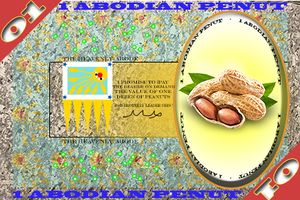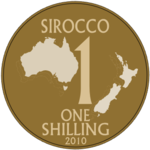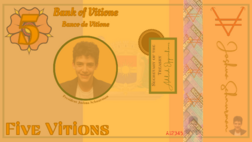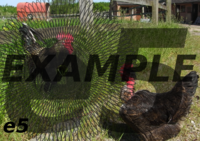Currency

A currency is a form of exchange or a receipt of work issued often by a government entity or other authorized monetary institution. Currencies may be used as tender to pay off a debt or a recognized object of value in place of actual goods in a transaction. For a micronation, the use of a currency is limited most often to an expression of nationalism by acting as an authority to print and issue legal tender, a method of promoting patriotism with the use of specific symbolic images, or to attempt an experiment into the use of a national economy. These currencies are mostly for entertainment purposes and are usually considered without true value, and will often tend to die out in a short time span. In some rare circumstances, these currencies can become popular amongst a group of people and eventually used as an actually recognized medium of exchange.
| Part of a series on |
| Micronational economics |
|---|
Production

Designing
After the parameters (its code, value, subunit, etc) of the currency have been established, the next required step is to make the design of the proposed currency. The most common ways of doing this are to draw them out on paper or to use a computer imaging program, such as Inkscape. The advantage of a computer design is its relative simplicity from image to printing or publishing online. Those who wish to publicly display their paper drawings use a scanner to enter them into a computer. Designing the images of a micronational currency can be often the first and final step in the creation of some currencies. The difficulty in producing physical examples of a currency leaves many in a situation with no place left to go once they are planned out. A lack of effort or desire to further the progress in making a full use currency also may ensue by this time.
Printing and minting

The printing and minting of banknotes and coins in micronationalism is limited due to the required materials and infrastructure needed for quality products. With the average person, micronations generally have a printer and printer paper at their disposal, which can create banknotes with limited durability. Some have been able to gather further supplies aimed at making higher-quality notes and additionally with security measures against counterfeit. Ultraviolet inks and other special printing techniques are the most widely used. Coins, on the other hand, are the least in supply. While macro coins are able to be smashed and chiseled with crude dies and minting techniques, this act can be illegal in the macronation that some micronations reside. Most micronations that have proper coinage are usually like the Principality of Sealand or other famous ones with available resources, as there are high costs associated with minting. Pattern one-off mintings have been made by some entities.

Designs

The images used on micronational currencies are most often influenced by their country of origin, the symbols of the micronation itself, and the political nature of the nation. Commonly, a denomination of the currency may include the image of the leader or other government officials, the flag or coat of arms, or pictures of areas from the micronation, including wildlife. Other related images may be used, as important political figures from history or leaders of the macronation of residence. Also seen on many currencies are political items, like hammers and sickles for nations based in leftist ideologies.
Use & Purpose
Nationalism

When a micronation is founded on a basis of either a secessionist movement or as a front for a full-fledged government project, a currency becomes a required factor in order to complete the entire government sphere. With the advent of a currency, not only does it allow for an economic policy to be able to be debated upon in government, but it also gives an image of fiscal independence from the former mother state. The concept of printing money, an otherwise illegal act with macronational currency, forms a view of authority where normally impossible. These sorts of currencies may be some of the further progressed currencies because of the dedication for their completion, but may not have been prepared nor have the market to establish a full economy to complement the produced currency. This may lead to the application of the currency as less of a circulating system and more as a collector’s piece of possible value, depending on the nature and reserves of the nation that issued it.


Entertainment

Probably the most common reasoning behind the usage of a currency is for fun by a nation. However, like currencies issued in order to expand a nation’s seemed legitimacy, currencies issued for entertainment generally were not envisioned with the concept of an actual economy to back it up with. These may be the least prepared currencies to be functional in an application like their inherent use. Additionally, without any reason to progress in production beyond what the designer(s) felt like doing, the project may fall apart at any obstacle or stagnation in progress. Entertainment currencies are almost always for collectors or display purposes. They may also be produced to be able to show off to others, or the point of a fun currency can be to make one just to make one, regardless of quality.


Economic experiment
Economics can be applied, and with greater efficiency, with a system of currency in a micronation. This can be used where a nation’s citizens each grow certain fruit-bearing plants, and the bartering across multiple persons to get an item would be required for a trade for the desired item would otherwise be utilized, without using a macronational currency. As with the original need to develop a currency, a micronational currency may be used to simplify the process and give a common value system to all products, and keeping real-valued macronational money separate. Other products may be sold instead of fruits, like art or clothing, in addition to payment for use of another citizen’s labor for a physical project
Online
Currencies for online purposes are used mostly as fiat currency based on either a limited supply of credit overall in general or for each user, or a pay per activity use system.
One approach involves using PHPBank or MyBanco plugins as a banking or exchange system. Another system, Newpoints, has payment in allotted amounts for activity in posts, views, and other forum functions, all of which can be applied to a user-ran shop and another option of a bank. These allow for encouragement in activity levels and credit for work in a recognized and relatively stable system.

Another type of online virtual currencies include the AlliCoin, which can be exchanged between citizens of Alaurentia. Unlike the methods above, AlliCoins are not automatically earned by posting. Instead, a fixed amount of AlliCoin (one million) exist throughout Alaurentia, providing some value to it. Users are automatically assigned a dedicated wallet upon registering on the Alaurentia forum, and earn these using the official shop or in any manners similar to real coins (donation request, service agreement, "buy now" item, etc.).
Real currency

In the rarest of occasions, a currency from a micronation may become tender recognized outside the limits of the few who originally made it. Once a micronational currency reaches this level, it becomes a form of a local currency. The reason for a currency to reach this level can be sometimes attributed to a depletion of the local macronational currency supply which then can limit the ability for what are usually smaller communities to operate.
Issues
Issues involved with the use of currencies produced by a micronational entity is the lack of safeguards against its loss of value, and no history of an established policy in which to control them. Should a nation gain a store of bullion or another valued reserve, the confidence in the nation’s ability to keep the value steady and act against possible fallouts would be small. Also, because of their common fiat nature, the average currency carries no real-world weight in which to buy real-world goods. Unless the micronation engages in an experimental economy that includes the use of domestic goods, an initial payment in a macronational currency has to be made for goods to be available on a micronational currency’s market. Should the currency fail, the party(ies) who paid the initial start-up would lose their entire investment. These diminish the capabilities for a currency to gain a real use status.For example,Sabah autonomous community of Taman ria does not produce its own currency, instead of relying on foreign currency such as the Malaysian ringgit.